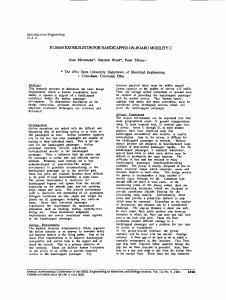Архив категории Ищем научные статьи
Kinematic Design to Improve Ergonomics in Human Machine Interaction
- Тип контента: Научная статья
- Номер документа: 978
- Название документа: Kinematic Design to Improve Ergonomics in Human Machine Interaction
- Номер (DOI, IBSN, Патент): 10.1109/TNSRE.2006.881565
- Изобретатель/автор: van der Helm, F.C.T., Schiele, A.
- Правопреемник/учебное заведение: Dept. of Mech. Eng., Delft Univ. of Technol.
- Дата публикации документа: 2006-12-19
- Страна опубликовавшая документ: Нидерланды (Голландия)
- Язык документа: Английский
- Наименование изделия: Не заполнено
- Источник: http://ieeexplore.ieee.org/search/freesrchabstract.jsp?tp=&a
- Вложения: Не заполнено
- Аналитик: Не заполнено
 This paper introduces a novel kinematic design paradigm for ergonomic human machine interaction. Goals for optimal design are formulated generically and applied to the mechanical design of an upper-arm exoskeleton. A nine degree-of-freedom (DOF) model of the human arm kinematics is presented and used to develop, test, and optimize the kinematic structure of an human arm interfacing exoskeleton. The resulting device can interact with an unprecedented portion of the natural limb workspace, including motions in the shoulder-girdle, shoulder, elbow, and the wrist. The exoskeleton does not require alignment to the human joint axes, yet is able to actuate each DOF of our redundant limb unambiguously and without reaching into singularities. The device is comfortable to wear and does not create residual forces if misalignments exist. Implemented in a rehabilitation robot, the design features of the exoskeleton could enable longer lasting training sessions, training of fully natural tasks such as activities of daily living and shorter dress-on and dress-off times. Results from inter-subject experiments with a prototype are presented, that verify usability over the entire workspace of the human arm, including shoulder and shoulder girdle
This paper introduces a novel kinematic design paradigm for ergonomic human machine interaction. Goals for optimal design are formulated generically and applied to the mechanical design of an upper-arm exoskeleton. A nine degree-of-freedom (DOF) model of the human arm kinematics is presented and used to develop, test, and optimize the kinematic structure of an human arm interfacing exoskeleton. The resulting device can interact with an unprecedented portion of the natural limb workspace, including motions in the shoulder-girdle, shoulder, elbow, and the wrist. The exoskeleton does not require alignment to the human joint axes, yet is able to actuate each DOF of our redundant limb unambiguously and without reaching into singularities. The device is comfortable to wear and does not create residual forces if misalignments exist. Implemented in a rehabilitation robot, the design features of the exoskeleton could enable longer lasting training sessions, training of fully natural tasks such as activities of daily living and shorter dress-on and dress-off times. Results from inter-subject experiments with a prototype are presented, that verify usability over the entire workspace of the human arm, including shoulder and shoulder girdle
Категория: Ищем научные статьи | Нет комментариев »
EMG-based control for lower-limb power-assist exoskeletons
- Тип контента: Научная статья
- Номер документа: 972
- Название документа: EMG-based control for lower-limb power-assist exoskeletons
- Номер (DOI, IBSN, Патент): 10.1109/RIISS.2009.4937901
- Изобретатель/автор: Kiguchi, K., Imada, Y.
- Правопреемник/учебное заведение: Dept. of Adv. Syst. Control Eng., Saga Univ., Saga
- Дата публикации документа: 2009-05-15
- Страна опубликовавшая документ: Япония
- Язык документа: Английский
- Наименование изделия: Не заполнено
- Источник: http://ieeexplore.ieee.org/search/freesrchabstract.jsp?tp=&a
- Вложения: Не заполнено
- Аналитик: Не заполнено
 Power-Assist for lower-limb is expected by many physically weak persons to assist their daily activities. It is important for the power-assist robots that the assist motion is generated based on users motion intention. This paper presents a muscle-model-oriented EMG-based (electromyogram-based) control method to activate a lower-limb power-assist robot according to the users motion intention since the EMG directly reflects the users muscle activities. In the proposed method, a matrix which expresses the relationship between the muscle activities and the generating joint torque is applied to estimate the users motion intention in real-time. The effectiveness of the proposed control method was evaluated by performing experiments.
Power-Assist for lower-limb is expected by many physically weak persons to assist their daily activities. It is important for the power-assist robots that the assist motion is generated based on users motion intention. This paper presents a muscle-model-oriented EMG-based (electromyogram-based) control method to activate a lower-limb power-assist robot according to the users motion intention since the EMG directly reflects the users muscle activities. In the proposed method, a matrix which expresses the relationship between the muscle activities and the generating joint torque is applied to estimate the users motion intention in real-time. The effectiveness of the proposed control method was evaluated by performing experiments.
Категория: Ищем научные статьи | Нет комментариев »
Recognition of walking intention using multiple bio/kinesthetic sensors for lower limb exoskeletons
- Тип контента: Научная статья
- Номер документа: 970
- Название документа: Recognition of walking intention using multiple bio/kinesthetic sensors for lower limb exoskeletons
- Номер (DOI, IBSN, Патент): Не заполнено
- Изобретатель/автор: Young-Jo Cho, Su-Young Chi, Sang Seung Kang, Jae-Yeon Lee, Eun-Hye Jang, Byung-Tae Chun
- Правопреемник/учебное заведение: Robot/Cognition Syst. Res. Dept., Telecommun. Res. Inst., Daejeon, South Korea
- Дата публикации документа: 2010-11-17
- Страна опубликовавшая документ: Корея
- Язык документа: Английский
- Наименование изделия: Не заполнено
- Источник: http://ieeexplore.ieee.org/search/freesrchabstract.jsp?tp=&a
- Вложения: Не заполнено
- Аналитик: Не заполнено
 In order to assist the lower limb disabled people to walk, walking-support exoskeletons with bio/kinesthetic sensors such as EMG (Electromyography), gyroscope, and FSR (Force Sensing Resistor) have been developed. It is important to implicitly recognize the walking intention and control the walking-support mechanism. The objective of this work is to examine the walking intention while a person is walking with Lofstrand crutches by analyzing multiple bio/kinesthetic sensor signals. We developed watch/glove and shoe-insoles sensor modules using FSR sensors to recognize the user’s walking states as well as intention to walk. The FSR signals measuring force at the palm and Gyro sensor signals reflecting the pose of the upper limb were used as clues for recognizing walking intention. While seventeen normal subjects walked for five gate cycles based on the triped walking (i.e., placing crutches in forward and then moving one step) with crutches, the FSR and Gyro signals were acquired from their palms and area of vertebrae lumbales. The result showed that the combination of FSR and Gyro signals could recognize user’s implicit intention to walk — start walking, keep walking, and stop walking.
In order to assist the lower limb disabled people to walk, walking-support exoskeletons with bio/kinesthetic sensors such as EMG (Electromyography), gyroscope, and FSR (Force Sensing Resistor) have been developed. It is important to implicitly recognize the walking intention and control the walking-support mechanism. The objective of this work is to examine the walking intention while a person is walking with Lofstrand crutches by analyzing multiple bio/kinesthetic sensor signals. We developed watch/glove and shoe-insoles sensor modules using FSR sensors to recognize the user’s walking states as well as intention to walk. The FSR signals measuring force at the palm and Gyro sensor signals reflecting the pose of the upper limb were used as clues for recognizing walking intention. While seventeen normal subjects walked for five gate cycles based on the triped walking (i.e., placing crutches in forward and then moving one step) with crutches, the FSR and Gyro signals were acquired from their palms and area of vertebrae lumbales. The result showed that the combination of FSR and Gyro signals could recognize user’s implicit intention to walk — start walking, keep walking, and stop walking.
Категория: Ищем научные статьи | Нет комментариев »
Human Exoskeleton For Handicapped On-board Mobility II
- Тип контента: Научная статья
- Номер документа: 964
- Название документа: Human Exoskeleton For Handicapped On-board Mobility II
- Номер (DOI, IBSN, Патент): 10.1109/IEMBS.1991.684771
- Изобретатель/автор: Weed, H., Sikora, P., Mortensen, A.
- Правопреемник/учебное заведение: The Ohio State University
- Дата публикации документа: 2002-08-06
- Страна опубликовавшая документ: США
- Язык документа: Английский
- Наименование изделия: Не заполнено
- Источник: http://ieeexplore.ieee.org/search/freesrchabstract.jsp?tp=&a
- Вложения: Не заполнено
- Аналитик: Не заполнено
Категория: Ищем научные статьи | Нет комментариев »
Improved stability in lower extremity exoskeletons using foot extensions
- Тип контента: Научная статья
- Номер документа: 962
- Название документа: Improved stability in lower extremity exoskeletons using foot extensions
- Номер (DOI, IBSN, Патент): Не заполнено
- Изобретатель/автор: Kumar, R.P., Jungwon Yoon
- Правопреемник/учебное заведение: Res. Center for Aircraft Parts Technol. (ReCAPT), Gyeongsang Nat. Univ., Jinju, South Korea
- Дата публикации документа: 2009-11-13
- Страна опубликовавшая документ: Корея
- Язык документа: Английский
- Наименование изделия: Не заполнено
- Источник: http://ieeexplore.ieee.org/search/freesrchabstract.jsp?tp=&a
- Вложения: Не заполнено
- Аналитик: Не заполнено
 Existing lower extremity exoskeletons lack sufficient foot support area to guarantee safe operation for rehabilitation of patients, and normal posture/gait for users carrying heavy loads on backpack. In order to enhance the stability of lower extremity exoskeletons, an adaptive foot system is presented. It consists of two foot extensions, one extending behind the toe and another on the heel side that extends the support area behind the heel when the foot is flat and retracts when the heel is off the ground. Such a system has an important application in rehabilitation for enhancing stability where safety of patients is critical. We present a detailed description of the adaptive foot system and analyze the stability in sagittal plane.
Existing lower extremity exoskeletons lack sufficient foot support area to guarantee safe operation for rehabilitation of patients, and normal posture/gait for users carrying heavy loads on backpack. In order to enhance the stability of lower extremity exoskeletons, an adaptive foot system is presented. It consists of two foot extensions, one extending behind the toe and another on the heel side that extends the support area behind the heel when the foot is flat and retracts when the heel is off the ground. Such a system has an important application in rehabilitation for enhancing stability where safety of patients is critical. We present a detailed description of the adaptive foot system and analyze the stability in sagittal plane.
Категория: Ищем научные статьи | Нет комментариев »
Статистика
Категорий: 179
Статей всего: 2,003
По типу:
Видео: 36
Выдержка с форума: 1
Контактные данные: 12
Научная статья: 1388
Не заполнено: 5
Новостная статья: 317
Обзор технологии: 42
Патент: 219
Тех.подробности: 34
Тип: 1
Комментариев: 8,654
Изображений: 3,005
Подробней...
ТОР 10 аналитиков
-
Глаголева Елена - 591
Дмитрий Соловьев - 459
Helix - 218
Ридна Украина))) - 85
Наталья Черкасова - 81
max-orduan - 29
Елена Токай - 15
Роман Михайлов - 9
Мансур Жигануров - 4
Дуванова Татьяна - 3
Календарь
| Пн | Вт | Ср | Чт | Пт | Сб | Вс |
|---|---|---|---|---|---|---|
| « Ноя | ||||||
| 1 | 2 | 3 | 4 | 5 | ||
| 6 | 7 | 8 | 9 | 10 | 11 | 12 |
| 13 | 14 | 15 | 16 | 17 | 18 | 19 |
| 20 | 21 | 22 | 23 | 24 | 25 | 26 |
| 27 | 28 | 29 | 30 | 31 | ||
Авторизация
Ошибка в тексте?
Выдели её мышкой!
И нажми Ctrl+Enter

